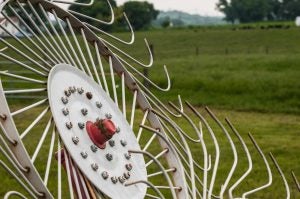You know the saying, “Hay is for horses”? Well, I hate to break it to ya, but hay is not just for horses. Hay is used to feed a variety of different types of livestock. And there are many types of hay to feed. When it comes to looking for the best hay to feed your livestock, there can be many advantages and disadvantages. In this piece, we’ll walk through some examples of forages and where you can find them fitting into the lifestyle of livestock animals.
For hay, there are different ways to classify them. The types of hay we work with that are the most common are: Grass hay and legume hay. Grass hay is a long hollow stem that can grow up to 60 inches tall with leaves that can grow up to 17 inches long. Grass hay or pasture hay has 10.3 percent of crude protein, which compares to a legume hay like early bloom alfalfa with 17.3 percent of crude protein. Alfalfa, which is very high in protein and minerals, becomes slightly more palatable for livestock compared to other grass hays.
In addition to crude protein, hay markets factor in other characteristics such as acid detergent fiber, neutral detergent fiber, relative feed value, and total digestible nutrients. Hay can also fall into one of several rating categories — supreme, premium, good, fair, or utility — and a big emphasis is put on which cutting the hay came from (expect three cuttings on most years).

If you’re going to be baling hay this year, be sure to check out this piece on things to keep in mind.
While there are many many different types of hay, we’re going to narrow the focus and cover some of the most common ones:
Timothy Hay
Timothy is a type of grass hay, mainly for the horse market. It is a high energy, high fiber, and low protein feedstuff making it very easy for livestock to digest. Because of the low protein levels, yimothy hay is used as a filler to satisfy appetite without adding excess calories. Timothy has a tendency to be on the more expensive side, but good quality timothy hay will bring as much as alfalfa in the racehorse market. For race horses, timothy is good to keep in front of them all day long. Because timothy is so sensitive to high temperatures, a majority of it is grown in the Northeastern and upper Midwest states. For the state of New York, its hay crop acreage is majority timothy-legume mixtures.
Orchardgrass
Orchardgrass is slowly becoming a class favorite for the hay to feed your horses. Orchardgrass has good flavor and is considered to be a high fiber feedstuff. Additionally, orchardgrass has a high nutrient content with a high protein and higher calorie content when compared to timothy. Something unique about orchard grass hay is it is not sensitive to the time it needs to be cut in regards to nutrient content. Looking at orchardgrass vs. alfalfa hay, orchardgrass falls short and is not quite as rich with nutrients. Where will you find orchardgrass being grown? Well, in a variety of different places throughout the United States. Orchardgrass is found from the Atlantic coast to the Pacific coast and from Maine to the Gulf Coast states. Also found throughout the Appalachian Mountains, orchardgrass is adaptable to high-rainfall areas of the western mountains as well as irrigated regions throughout the West.
Oat Hay
Oat hay is full of benefits for a majority of livestock for several reasons. Oats can be used in a variety of ways, but oats are one of the most under-used, and it is able to grow during cool spring and fall weather when the moisture in the soil is used most efficiently to produce forage. It grows quickly and has good value. Oat hay is supreme for young livestock consumption if cut at the perfect time when the oats bloom. You can also feed stock cows on oat hay that is cut a little bit later, increasing your yield. Oats are primarily found growing in a cool temperature climate. Oats are grown in many states within the U.S., but the top three oat producing states are South Dakota and North Dakota, followed by Wisconsin.

Triticale
Triticale is a hybrid of rye and wheat hay. The reason this mix came about was because wheat has many advantages to it and rye can thrive in many different climate conditions, so it was in the best interest to cross the two. Triticale is a very high versatility feedstuff used for not only hay but also for silage and grazing livestock on. Triticale is a high digestibility and high protein forage perfect for both dairy and beef cattle. Triticale has recently been gaining an increasing interest in the horse market as well due to its added nutritional value. A majority of triticale is grown in the West Coast regions and the Central Great Plains.
Alfalfa
Alfalfa is a great source of good quality protein. It is important in lactating dairy cattle, which need a high amount of protein and high energy feedstuff. It meets dairy quality for digestible protein. Alfalfa hay is very palatable for a majority of livestock, meaning they love the taste. But on the other side of things, alfalfa can also cause many negatives if too large of a portion is given to any one animal. Livestock can bloat very easily on alfalfa due to the high amounts of protein. Think of it for humans, if we consume over the recommended limit of protein in our diets, typically we would be both very gassy and bloat up like you just ate Thanksgiving dinner. So it is important to pay attention to your livestock, because if an animal becomes bloated and continues to eat alfalfa, the end results can be as critical as death. A testament to its popularity and functionality, Alfalfa is produced and sold in all 50 states.
All types of hay have a place in the world when it comes to feeding animals, but what animal you are feeding it too is what makes the difference. Plus, both round and square hay bales are fun to decorate at Halloween.
Valley Urricelqui shares her passion for the agriculture industry one day at a time. You can visit her blog or follow her on Facebook or Instagram.



